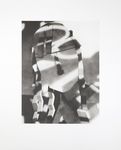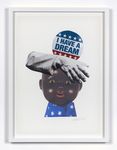Why Some Artists Turn Away Would-Be Buyers
←
→
Page content transcription
If your browser does not render page correctly, please read the page content below
Artsy
Why Some Artists Turn Away Would-Be Buyers
Alina Cohen
27 March 2020
Why Some Artists Turn Away Would-Be Buyers
Image: When you see me, Deborah Roberts, 2019.
Courtesy of Stephen Friedman Gallery
Most creative people have little control over who
enjoys—or doesn’t enjoy—their work. Dancers,
musicians, and Broadway actors open their
performances to anyone who can purchase a ticket.
Cinemas sell seats until the theater fills. Bookstores
place no restrictions on who can buy books. The
barrier to access is often economic. If you can pay
the price of admission, you can experience the art.
Image: Armor, Deborah Roberts, 2018. Courtesy of Stephen Friedman Gallery
Image: One history, two versions (Bullet Points), Deborah Roberts, 2019.
Courtesy of Stephen Friedman Gallery
Visual art, however, works differently. Galleries typically sell one sculpture,
painting, photograph, video, or limited edition of those media at a time to
private collectors and institutions. This structure has encouraged some
artists to be more scrupulous about their sales. To own their art, collectors
must meet certain criteria related to their ideologies, financial backgrounds,
reputations, and plans for exhibiting the artists’ work. Though placing art is
traditionally a gallery’s job, a number of artists take steps to exert greater
control over their own legacies. Abstract Expressionist painter Clyfford Still
may be the most famous art-historical example of this practice: He refused
25—28 Old Burlington Street London W1S 3AN
T +44 (0)20 7494 1434 stephenfriedman.comArtsy
Why Some Artists Turn Away Would-Be Buyers
Alina Cohen
27 March 2020
to work with a gallery, keeping thousands of canvases and handling most sales himself.
One of the most common ways for artists to influence their markets is by privileging direct sales to museum
collections and to private collectors with close institutional ties. While many galleries prioritize such sales
anyway, some artists are more adamant about this desire.
Institutional priority
Image: Future Tense, Deborah Roberts, 2018.
Courtesy of Stephen Friedman Gallery
Deborah Roberts, who shows with Vielmetter
Los Angeles and London’s Stephen
Friedman Gallery, is candid about her
wishes. She directs her galleries to sell to
museums, she said, so that “someone who
looks like me can be inspired by my work and
think, ‘I could do this too.’” As an African
American woman who grew up in a lower
socioeconomic bracket, museums were one
of the few places she could see herself
reflected in American culture. In these public
spaces, she found models for how to paint.
Sometimes, Roberts told me, a gallery will come to her with an offer from “an amazing collector.” They’ll tell her
which artists are already represented in the collection and share why it’s important to have work there, too. “I
have relented,” she admitted. Yet she’s also getting more vocal. Now, if the gallery doesn’t make an offer that’s
suitable to her, Roberts will simply ask for the artwork back. She’d rather have her art than the funds.
Image: Genevieve Gaignard, Sell To Black
Collectors (Pink), 2020. Courtesy of the artist
and Vielmetter Los Angeles.
A few years ago, Roberts made a series of
mixed-media paintings about George
Stinney Jr., a 14-year-old African American
boy who was wrongfully convicted of
murdering two white girls and executed in
the early 1940s. Roberts wanted all these
works in public collections. “Three ended up
in private collections, which I’m still salty
about,” she said. “A lot went to public
collections where people can learn his story,
which I’m happy about.”
25—28 Old Burlington Street London W1S 3AN
T +44 (0)20 7494 1434 stephenfriedman.comArtsy
Why Some Artists Turn Away Would-Be Buyers
Alina Cohen
27 March 2020
Connecting with collectors who care
Image: Nadine, Avery Singer, 2014. Glasgow International
Image: Architect as Dragoman, Michael Rakowitz, 2015. Rhona Hoffman
Gallery
Artists’ motivations, when they specify that they want their works to go to
museums, can be more economic than ideological. “Most Lower East Side
dealers do their best to select people who will care for the work and who
don’t treat it like a commodity,” said Jasmin Tsou, owner and director of the
gallery JTT. In other words, selling to private collectors always creates a risk
that many young artists want to avoid: seeing their work turn up at auction.
That said, some artists see significant value in selling to a diverse group of
private collectors. Genevieve Gaignard noted that she has started
advocating “access for collectors of color.” Black artists and their works are
being celebrated right now, and, she said, “it’s fitting that the work would
be able to live amongst at least some of the folks it’s representing.”
Gaignard echoed Roberts in saying that, for so long, people of color couldn’t see themselves “represented in
visual stories of America and beyond.” She believes that when there’s high demand for an artist’s work, “it’s
important for collectors of color to be given early access to previews and first rights to purchase,” she said. “So
often, they are left off these lists.”
Image: Inshallah at Sabratha, Michael Rakowitz, 2011-2012,
Jane Lombard Gallery
Artists whose works are in high demand may also have
requirements about specific sales. Avery Singer, for example,
reportedly mandated that all four works in her presentation
at Hauser & Wirth’s booth at Frieze Los Angeles go to
institutions. This didn’t mean that a museum’s acquisitions
committee had to buy them. Private collectors can purchase
25—28 Old Burlington Street London W1S 3AN
T +44 (0)20 7494 1434 stephenfriedman.comArtsy
Why Some Artists Turn Away Would-Be Buyers
Alina Cohen
27 March 2020
artworks that they promise to certain institutions—often with the hope of getting to acquire a work for themselves
later.
The conceptual artist Andrea Fraser may be the most famous contemporary exemplar of artists’ fraught
relationships with private collectors. She’s worked on and off with galleries for years, selling (and not selling)
work that critiques both art museums and the market, like her extensive catalog of U.S. museum trustees’ political
donations during the 2016 presidential election. Her infamous 2003 work Untitled involved sleeping with a
collector who “bought” the piece, which comprised the evening itself and a video of the event.
Seal of approval
Image: Rendering for Aten Reign, James Turrell, 2013. Guggenheim
Museum
Some artists are even more specific about who can and can’t
purchase their works. Michael Rakowitz, for example, is part of the
Gulf Labor Artist Coalition, which advocates for the rights of
migrant workers building institutions on Abu Dhabi’s Saadiyat
Island, including a new branch of the Guggenheim. Rakowitz is
cautious about selling work to any institution targeted by Gulf
Labor’s boycott, or individuals affiliated with them. Yet according
to his dealer, Jane Lombard, that’s not an issue on her end. Her
gallery has been fortunate, she said, “because his political views are well known.” If you’re looking to buy a
Rakowitz work, you’re probably aware of his restrictions.
Lombard said that in her experience, artists will make specifications regarding who can collect their works “based
on their personal grievance, political views, and the causes for which they are passionate.” She believes it’s
“becoming more common for artists to have issues with institutions,” she said. On the other hand, Scott Briscoe,
manager at Sikkema Jenkins & Co., said that while there have been exceptions, most of his artists don’t “ask to
be consulted as to whom buys their work.” He would not reveal what those exceptions were.
Making collectors commit
Image: Medium Rectangle Glass, James Turrell, 2019. Kayne Griffin Corcoran
25—28 Old Burlington Street London W1S 3AN
T +44 (0)20 7494 1434 stephenfriedman.comArtsy
Why Some Artists Turn Away Would-Be Buyers
Alina Cohen
27 March 2020
Image: Pass-Thru, Cameron Rowland, 2013. The Studio Museum
in Harlem
Sometimes, an artist’s requirements are simply aesthetic. James
Turrell’s monumental light works, for example, have very specific
logistical requirements. “Everyone loves the ‘Glass’ works, but
only a handful of collectors are willing to commit to the
architectural buildouts required to install these works,” said
Beatrice Shen, director of sales at Kayne Griffin Corcoran,
referring to the artist’s series of installations featuring cutaways
lined with LEDs that gradually shift colors. To install a “Glass”
work, an owner must create a kind of window within a wall, to hold
the light and color. “The collectors need to be visionaries,” Shen
said.
Turrell’s “Skyspaces” require even more exacting architectural
parameters. Collectors must have—or build—specifically proportioned chambers. They must be able to carve an
aperture in the ceiling to “frame the open sky,” according to Andrew Black, the gallery’s director of
communications.
At the far end of the spectrum is Cameron Rowland, who prohibits anyone from buying their work at all. Instead,
institutions and individuals may rent them. To take a Rowland work home, or back to the museum, interested
parties must sign a contract. This process forces the buyer to recognize Rowland as a producer of property with
their own rights—a privilege not always afforded to artists.
Selling an artwork, unlike selling a book or a ticket to a movie, requires artists to part with something dear to
them, which they may never see again. But to sustain their livelihoods, and to generate any recognition for their
work, they have to keep putting themselves through this difficult process again and again. Given the physical and
emotional work they put into their practices, it’s not surprising that some artists want to have a say in where the
fruits of their labour end up.
25—28 Old Burlington Street London W1S 3AN
T +44 (0)20 7494 1434 stephenfriedman.comYou can also read



























































